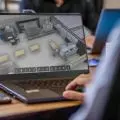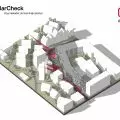Article fromA&B 06|2023 issue
By creating, we destroy. That's the truth about the architectural creative process, although one would like to think otherwise. That's how we've arranged it for ourselves, and that's how we think to make ourselves feel better. We even managed to choose the right semiotics for it. After all, the family of architects, those from the landscape too, is the intelligence of the Second Great Group in the classification of professions.
But no matter how we try while "designing responsibly" on the computer screen, or any other eco and bio, the investment process we will inflict on a particular space will still be a process of destruction and destruction. After all, it is written: "make the earth subject to yourselves," so what are you Januszczyk clinging to? The designer like a demiurge creates and subjects the space. He makes it subject to his species.
How about trying a little different? Instead of writing farmaise that the glass skyscraper and the landscaping realized next to it in a wasteland area are bio and eco and recycling and God knows what else, think for a moment about every line put on the screen? And then make a decision before myself: do I go in the direction of destruction or less destruction?
I think that if the starting point for our consideration and "responsible design" is less destruction, then we are already on an interesting path. If we connect the dots and conclude that we are sizing up the most valuable spaces from the point of view of urban biodiversity or the oh-so-important retention in this our creative process culminating in implementation, then we have already taken the first step on this path. And if the next step is, for example, the realization that in such a situation their current name "wasteland" is somehow so incompatible with what function they really serve, then there will already be several steps, including a milestone. Maybe that's when our hand holding the little gray mouse will tremble slightly and we will think of our process not as creation, but as interference in an already heavily degraded environment.
Our entire operation is burdened with a large carbon and water footprint, long supply chains, drawing from non-renewable sources, and once something is created, it is often not recyclable. We are locked into the processes of the linear economy, which has become the only legitimate religion of the designers of our time. This applies not only to buildings, but also to land development or 99.9 percent of engineering design. Some time ago a rabble was raised that bus stops were being designed against humanity, specifically against people experiencing homelessness. My impression is that nowadays almost all design is directed precisely against people, architectural design too. Of course, some architects were already thinking about compensation in the form of rooftop adaptations, fifth facades or green walls to return to nature what was taken away for investment. Green roofs still as a yes, but green walls, not those growing from the ground (vines), but so-called vertical gardens, are hardly an eco phenomenon. Their implementation and maintenance require engaging a lot of energy. As a landscape architect, I'm not against green or blue roofs or green facades, but what's important in all this is moderation and the realization that every activity of the investment process generates carbon dioxide (a greenhouse gas), even one that looks "green" and "ecological." If we fix this in our heads, we will begin to look at the reality around us differently. If, in addition, we introduce into the creative process, from the very beginning, so seriously, thinking about the circularity (GOZ) of construction objects and the use of nature's mechanisms for land use, it will be better for us and for future generations.
Without destruction
© Filipowski
But let's return to the title "without destruction." When we start the investment process, we most often enter a plot of land and destroy what exists there. This is often an unreflective action, an archetype that is not discussed. Plants, both shrubs and trees, and certainly "thickets and bushes" become the victims of our invasion. It's easier for us to cut down, put up buildings and plant a few rachitic trees as administrative, because not environmental, compensation. This is where I wonder most about us. Why are we not taking advantage of this potential? Why don't we use the existing vegetation for later design and construction activities? It won't work with all plants, and we won't always have the opportunity to do so, but it's worth trying. Make a good inventory before starting the design and use it to preserve as much vegetation as possible. Believe me, large existing trees are an added value, even in financial terms. In the United States, an algorithm was developed to calculate the ecological services of trees in a city. It turned out that one tree generates $10,000 in revenue per year, for example, because it makes people land in hospitals less often. New plantings and works cost money, often considerable sums. That's the financial argument, and the other, more important one is about human well-being. We actually feel better when surrounded by greenery of natural origin. Then there is the most important issue - limited investment processes, for example, those thought out at the pre-design and design stage, mean less greenhouse gas emissions, and thus not adding to the stove of climate change. A closed-loop economy and observation of nature, a change in the approach to space aesthetics and design narrative, and even name changes and clearing knowledge of urban myths and legends are homework for the next few years. When I hear that it can't be done, I quote a sung engineering classic under my breath: "There isn't a pipe in the world that can't be unclogged."

















